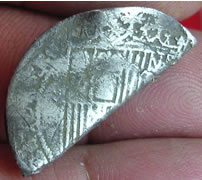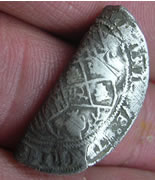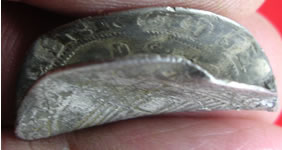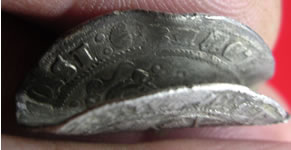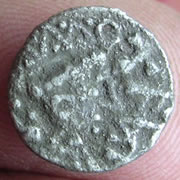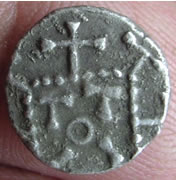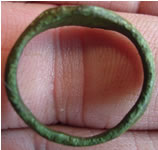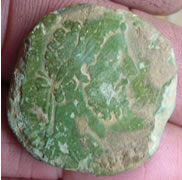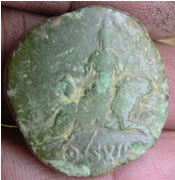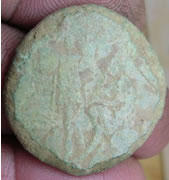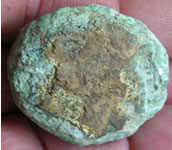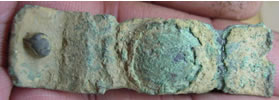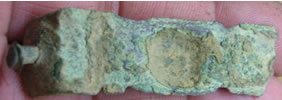

Metal detecting holidays in England with the World's most successful metal detecting club.
Twinned with Midwest Historical Research Society USA
Sept 2007 finds page |
|||
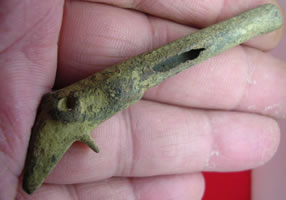 |
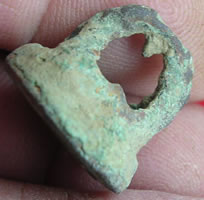 |
 |
|
|
Stunning
17thC working toy petronel pistol, note the barrel blew out due to overpacking
of gunpowder. |
17th/18thC
fob deal with bird impression |
||
 |
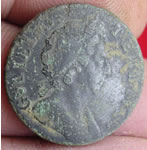 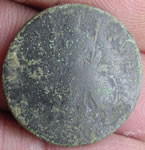 |
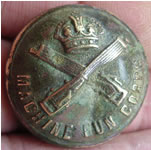 |
|
|
UNITED
KINGDOM MN - Wigram Line In use 1870 - 1915 ? Stewards Button Maker - Unknown |
Great
condition 1696 William III copper farthing |
WWI
Machine gun Corp |
|
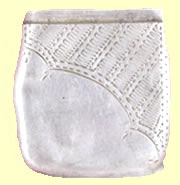 |
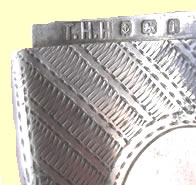 |
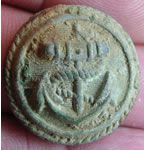 |
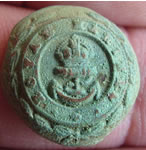 |
|
Birmingham
hallmark 1908 Silver vesta case - Maker T.H.H |
Generic
Merchant Navy Officer |
ROYAL
MARINES This button dates 1923 - 1952 O/R's Tunic Button Maker = Smith & Wright, B'ham RMLI & RMA merged in 1923 |
|
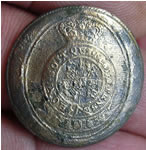 |
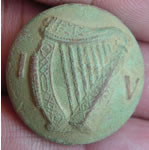 |
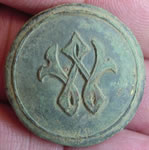 |
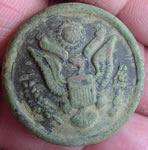 |
|
One piece Navy button HONI SOIT QUI MAN Y PENSE PACKET Honi soit qui mal y pense (Old French: shame upon him who thinks evil of it) RN - Packet Service c.1800-1811
|
Irish
Army 1920 |
1911 E Armfield & Co Birmingham |
WWI
- WWI USA GI button |
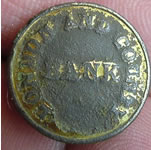 |
 |
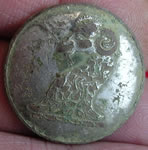 |
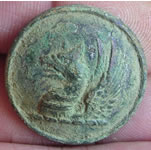 |
|
London and county Bank 1895 |
RN
Capt / Commander - 1901 Other Ship's Officers - 1901 |
19thC Rams head livery button |
1871-1873 Reynolds & Co 50 St Martins Lane London |
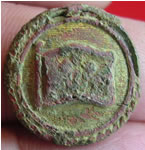 |
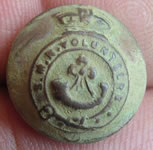 |
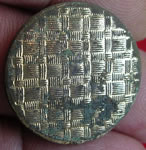 |
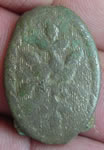 |
|
British
& Atlantic S.N. Co. The Liverpool Journal of Commerce chart for 1885 shows the British & Atlantic S.N. Co. with a white flag with red Prince of Wales's plumes in the centre |
S.M.R Volunteers Mounted Rifle Volunteers |
Georgian
gilded button |
18thC
clog fastener |
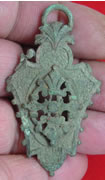 |
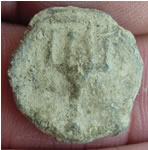 |
|
|
|
Victorian
harness pendant |
Saxon
period coin weight |
Circa
17th century
A slightly convex symmetrical gilded mount with lobed ends, transverse
ridges, and two integral pointed lugs |
|
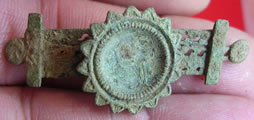 |
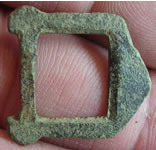 |
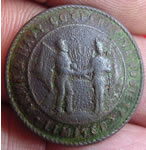 |
|
|
Victorian
decorated clasp
|
1550-1650
spur buckle |
Army
and Navy Co-opererative society |
|
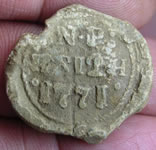 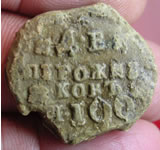 |
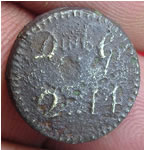  |
||
|
1771
Russian lead bale seal |
18thC
2 Pennyweight and 14 grain coin weight - half gold guinea
|
||
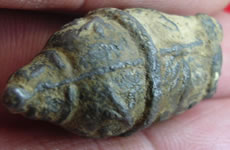 |
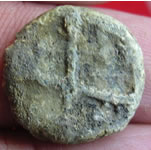 |
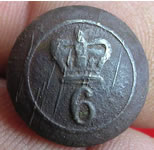 |
|
|
Decorated
hawking whistle |
15thC
lead token - long cross and pellet type |
Unrecorded
6th Regiment of foot button |
|
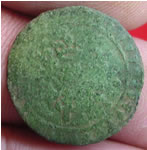 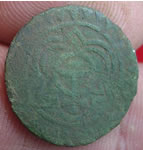 |
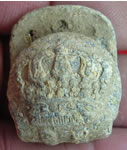 |
 |
|
|
1586 Hans Krauwincel
II Rose orb Jeton
HANNS KRAVWINCKEL IN
NVRENB |
1880 - 1918 Prussian
Army belt fitting |
1880 - 1918 Prussian
Army button |
|
|
15thC Spanish 8 real 2.76g 26.08mm Ferdinand of Aragon and Elisabeth of Castilla
|
|||
|
|
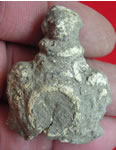 |
|
|
|
1199
King John hammered silver half penny - looks like Bury mint - need to
get the books out to check |
Decorated Victorian
finial with face design |
Saxon period hanger |
|
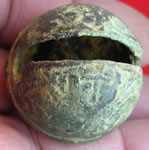 |
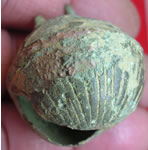 |
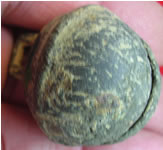 |
 |
|
16thC decorated crotal
bell with makers mark T |
17thc decorated crotal
bell |
17thc decorated crotal
bell |
?? |
 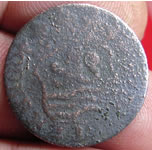 |
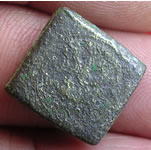 |
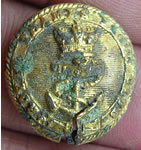 |
|
|
1754 Dutch Zeelandia
copper duit |
16thC coin weight Antwerp
type |
Royal Thames Yacht
club |
|
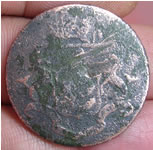
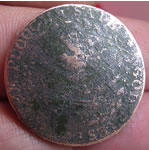 |
  |
||
|
18thC Conder token
- not checked it yet |
Circa
17th century
A large
mount in the form of an acorn; two integral pointed lugs on the back.
|
||
 |
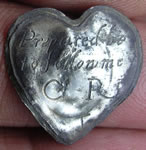 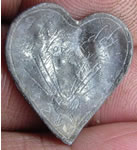 |
||
|
1662 silver button to commemorate Charles II marriage 12.91mm dia, 0.62g |
Mid 17thC Mourning silver token Obv 'Prepared be to follow me' CR T Rev 'I live and dy m loyal ye' 19.88mm L x 19.02 mm W 1.14g
|
||
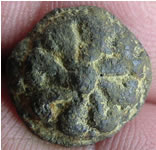 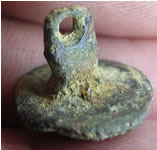 |
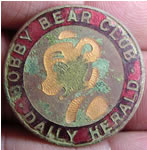 |
 |
|
|
16thC
decorated Tudor button |
Bobby
Bear club badge |
RN
Capt / Commander - 1901 Other Ship's Officers - 1901 |
|
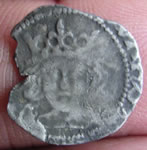  |
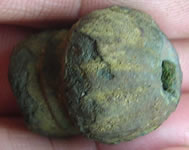 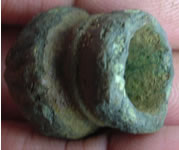 |
||
|
Henry V 1413-1422 0.68g |
Roman
bronze decorated knife pommel
|
||
  |
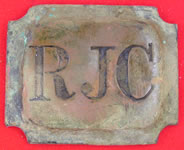 |
||
|
1625 Charles 1st hammered
silver half groat |
Georgian harness plate
with initials of farmer |
||
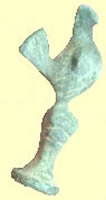 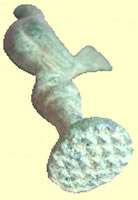  |
|||
|
Bronze bird pipe tamper
? could be earlier as it looks very detailed for a tamper - one for
the museum to look at |
|||
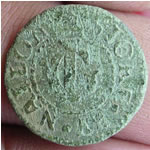 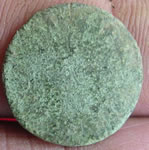 |
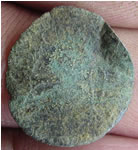 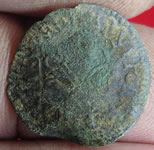 |
||
|
17thC John Groome of Stoke by Nayland Suffolk
Copper trade farthing |
1666 Thomas Peeke of
Colchester hammered copper trade farthing |
||
 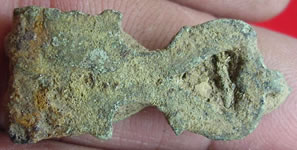 |
|||
|
17thC book clasp and
hinge - rivet fixings |
|||
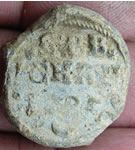 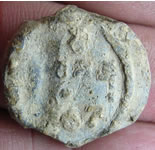 |
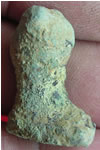 |
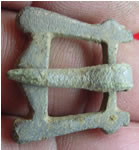 |
|
|
1785 Russian Bale seal Obv SPB I GHR U 1785 Rev Russian script ts, ya , E, Location O7 St Petersburg |
Smalll bronze staue
leg - possible Roman |
17thC spur buckle |
|
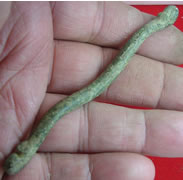 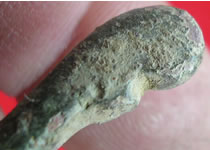 |
 |
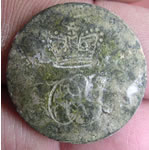 |
|
|
Curious find, copper
alloy bar with hanging notches are both ends, like a purse bar but not
as it the wrong shape, also like a balance scales but not. One to research
|
18thC Spur buckle |
Early one piece military
button - not checked the books yet |
|
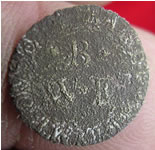 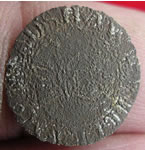 |
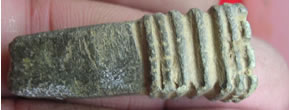 |
||
|
17thC hammered copper
trade farthing Bridport Dorset, William Bull |
Bronze decorated rectangular
piece - possible early bowl leg |
||
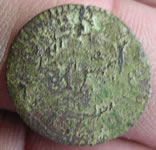 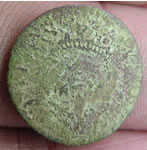 |
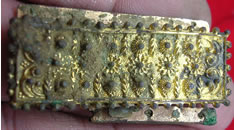 |
||
|
17thC trade farthing
- not checked the books yet |
Victorian gilded ornate
jewelry clasp |
||
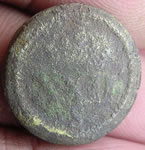 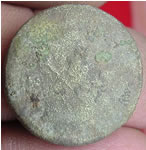 |
 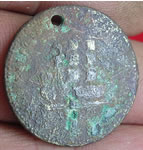 |
||
|
1603 James 1st XXIIs
gold coin weight |
What a great find - Lord Nelson medallion Victory at Trafalgar and death 'ADM Vicount Nelson Octb 21 1805' |
||
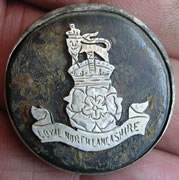  |
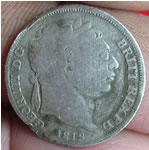  |
||
|
Really nice silver
inlay Loyal North Lancashire badge
|
1819 George III milled
silver sixpence |
||
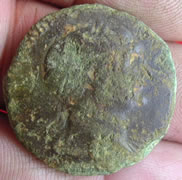 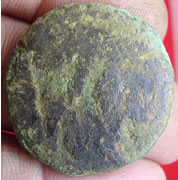 |
|||
|
1stC AD Roman bronze 28.44mm, 12.87g The quick answer is that it's Trajan, 97-117 A.D. (Hadrian's predecessor)
and so has every good reason to be in Britain. Given the diameter
and weight, it would be an As - also, although perhaps just a tad
heavy for an As at nearly 13gm, I see no traces of the radiate crown
which would indicate that it was a Dupondius (2 Asses). An interesting factoid about Trajan's coins: Not only did the Empire achieve its greatest size under his reign, the coins became longer-winded under him than any other ruler. Some of his sestertii have such an extensive laundry-list of his titles that they can have upwards of 75-80 characters in the obverse legend alone, then go on at even greater length on their reverses. For those of us who must type-up cards to go in coin-flips, Trajan's legends can be very challenging to fit onto a 2"x2" fliptag. I'll try enlarging, tweaking and rotating the reverse image to see if I can make any sense out of it, but, as I said, Trajan had so many reverse types it may be hopeless. Mark
|
|||
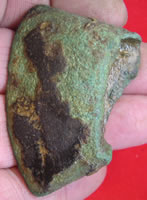 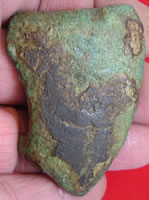 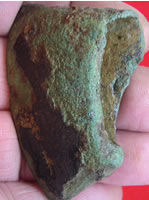 |
|||
|
C1000
BC Bronze Age socketed axe head fragment 37.44mm
L 55.91mm W x 13.52 mm T
|
|||
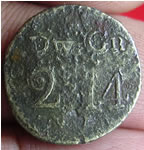 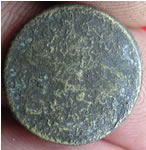 |
 |
|
|
|
1760's
2 pennyweights and 2 grains coin weight - 1/2 gold guinea
|
RN
Capt / Commander - 1787 RN Lieutenant - 1787 |
Circa
17th century
A slightly convex symmetrical mount
with lobed ends, transverse ridges, and two integral pointed lugs |
|
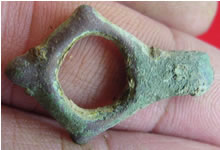 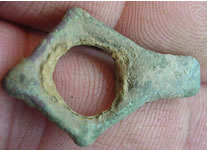 |
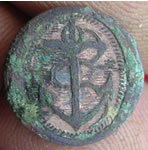 |
||
|
10th/11th
Saxon period bridal cheek piece fragment
|
RN
Capt / Commander - 1787 RN Lieutenant - 1787 |
||
|
Saxon C600-775 AD Silver Sceat - 1.13g,11.28mm '(Series C2), which
I have recorded as EMC 2007.0228'. |
|||
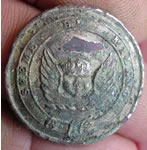 |
 |
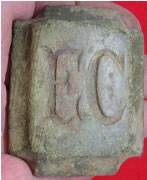 |
 |
|
'Semmi Di Milano' Maker R.E.Hayward 21 Rouverll St London |
1950's
lead toy plane |
Georgian
heavy horse harness name plate |
18thC
bayonet frog |
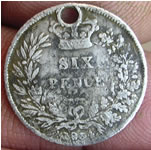 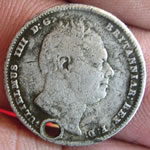 |
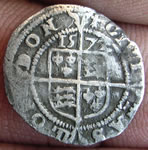  |
||
|
1834 William IIII milled
silver sixpence |
1572 Elizabeth 1st
hammered silver three half pence - intial mark Ermine 3rd issue with
rose and date |
||
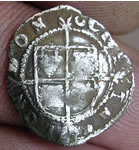 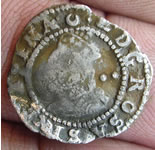 |
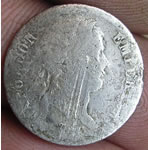  |
||
|
1589 Elizabeth 1st
hammered silver half groat ( 2 pence) - intial mark Crescent 5th issue
without rose or date |
French 1808 Napoleon
2 Franc milled silver coin
|
||
|
|
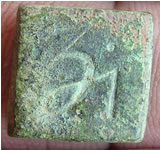 |
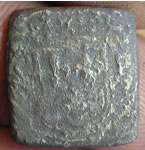 |
|
|
16thC decorated copper
alloy ring |
17th/18thC apothecary weight 1 dram |
1422- 61 Bronze uniface
Crowned Three lis in shield French Ecu gold coin weight 2.96g. Letters
by the shield indicate French not English version. |
|
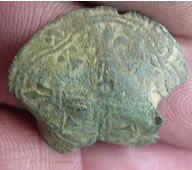 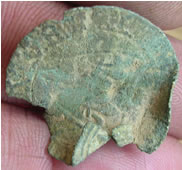 |
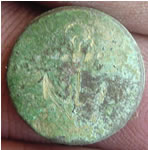 |
 |
|
|
French copper- alloy
Jeton 1380AD Obv Shield of France bearing three feur de lys |
Early Navy button -
not checked the reference books yet |
Victorian Generic Military HQ Staff Officer Smith & Wright 1840 -81 |
|
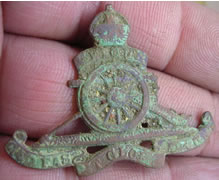 |
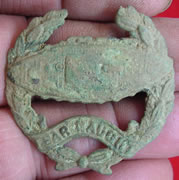 |
||
|
Royal artillery cap
badge |
Great find WWI tank
corp cap badge |
||
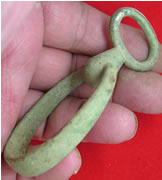 |
 |
 |
|
|
19thC sword hanger |
Military button - not
checked the reference books yet |
18thC clog fastener |
|
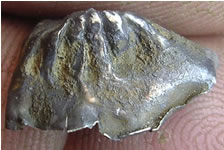 |
 |
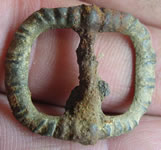 |
|
|
Medieval silver decorated
hawking bell fragment - reported as treasure - 10.08mm H x 17.03mm W,
0.65g |
18thC clog fastener |
1550-1650 buckle |
|
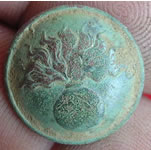 |
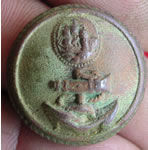 |
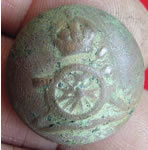 |
 |
|
French Infanterie de
ligne (1871-1916) |
Bristol Docks Authority
In use 1820 - 1992 |
Royal Horse Artillery
Generic Issue
|
18thC clog fastener |
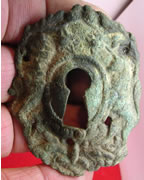 |
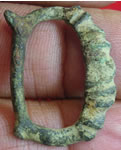 |
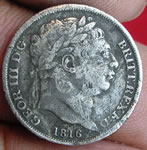  |
|
|
Georgian decorated
lock plate with unicorn design |
Medieval D buckle |
1816 George III milled
silver sixpence |
|
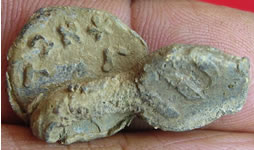 |
 |
||
|
Complete Post medieval
lead cloth seal |
Post medieval copper
alloy casket hinge |
||
  |
  |
||
|
1800's Russian lead
bale seal |
Medieval mount or hanger
with 2 rivet fixogs |
||
 |
  |
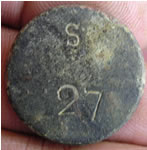 |
|
|
18thC clog fastener |
Interesting piece -
Number 3 made out of nails ? |
Possible bullion weight
- not checked books yet |
|
  |
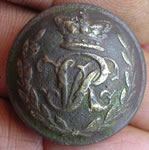 |
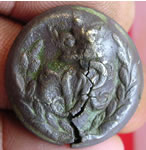 |
|
|
Circa
17th century
A large
mount in the form of an acorn; two integral pointed lugs on the back.
|
Victorian Generic Military HQ Staff Officer Smith & Wright 1840 -81 |
Victorian Generic Military HQ Staff Officer Smith & Wright 1840 -81 |
|
 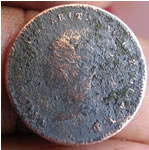 |
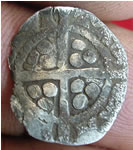 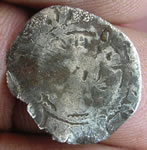 |
||
|
Neat copper -1853 Victorian
1/2 farthing (1/8th of a penny) |
1272 AD Edward 1st
hammered silver penny |
||
 |
|||
|
Printing press block
? |
|||
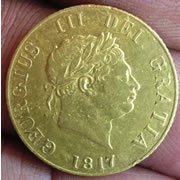 |
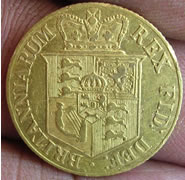 |
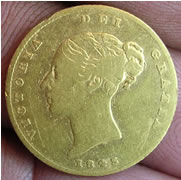 |
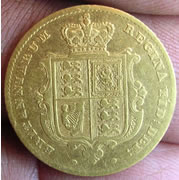 |
|
1817
George III gold half sovereign - new coinage type |
1843
Victoria gold half sovereign |
||
 |
 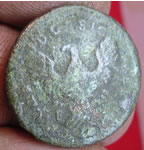 |
 |
|
|
Post medieval Bronze
leg and foot |
1717 Foreign copper
coin - not checked ref books yet |
15thC lead token |
|
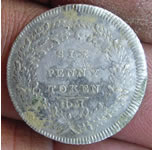  |
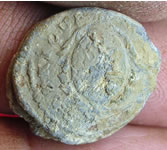  |
||
|
19thC
Silver 6 penny token HM - Payable by a £1 note for 40 of these
at Morgans toekn manufactory 12 Rathbone place London |
Post
medieval lead cloth seal
|
||
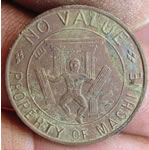 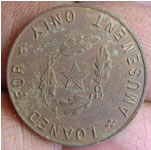 |
 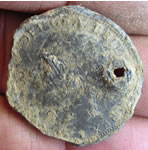 |
||
|
20thC
fruit machine token |
George
V Florin (2 shillings) forgery |
||
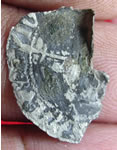  |
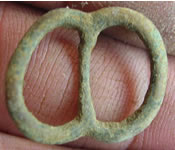 |
||
|
16thC
Elizabeth 1st hammered silver sixpence |
1550
- 1650 buckle
|
||
 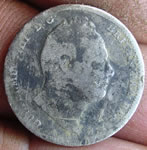 |
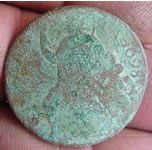 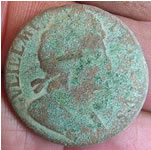 |
||
|
1831
William IIII milled silver six pence |
Great
condition 1698 William III copper half penny
|
||
  |
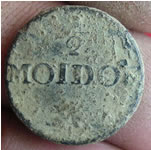 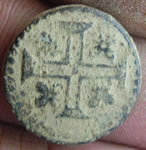 |
||
|
Medieval
copper alloy mount - 2 rivet fixing |
ca
1720-40 1/2 Moidor Portuguese gold coin weight
|
||
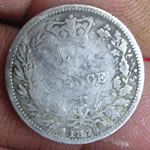 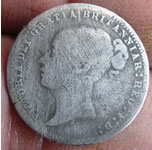 |
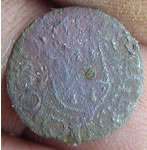 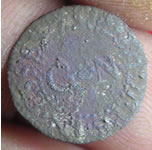 |
||
|
1879
Victorian milled silver sixpence |
17thC
George Nicholson hammered copper trade farthing - grocers, Thorpe le
Soken Essex - not dated type
|
||
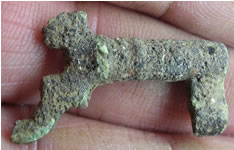 |
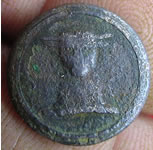 |
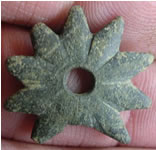 |
|
|
Medieval
bronze key |
19thC
livery button |
Medieval
spur rowell |
|
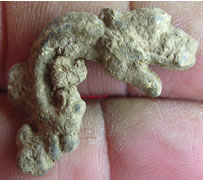 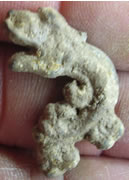 |
|||
|
Facinating
lead dragon find -dated as Medieval |
|||
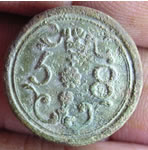 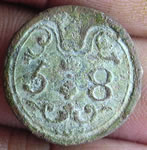 |
 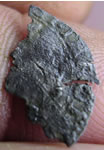 |
||
|
18thC
5 pennyweights
and 8 grains coin weight - gold guinea |
1625
Scottish Charles 1st hammered silver 20 pence
|
||
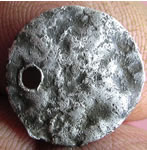  |
 |
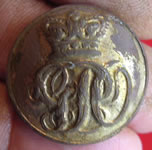 |
|
|
Hammered
silver half groat made into a medallion |
Huge
19thC Royal Exchange Insurance button |
Could
be 19thC General Post Office |
|
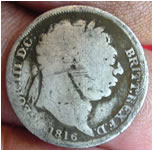 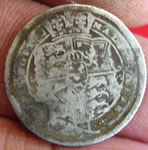 |
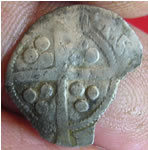 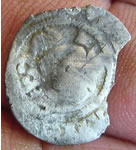 |
||
|
1816
George III milled silver six pence |
1272 AD Edward 1st
hammered silver penny
|
||
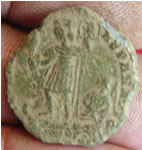  |
|||
|
Really
crisp
4thC Roman bronze - sent off for ID 2.93g, 19.67mm You're
probably already aware it's Constantius II (337-361 A.D. - Constantine's
youngest son and longest-surviving of his successors)- although the
fact that it's his and not his brother's is not quite as obvious as
you might think - older brother Constans shared the purple with Constantius
until 350 A.D. and so had an almost equal number of the earlier types
of FEL TEMP REPARATIO's struck in his name. It's the fact that the
legend breaks where it does - DN CONSTAN - TIVS PF AVG - that shows
that it's Constantius rather than Constans - his legend would break The reverse
type is one of those marvels of Roman symbolic art - they packed a
lot of PR (some might say propaganda) into those reverse types. This
was really one of the few venues for official mass-media in the proto-literate
Roman era - which lacked any of the communication devices we take
for granted like newspapers, etc. Too bad the exergue is unclear - we won't be able to be certain about where it was minted unless a little careful cleaning in that area reveals some detail - I'll guess it's a Western European mint on the rather vague basis of "style". I was hoping the fact that there's no officina or sequence marks in the reverse fields might narrow down the list of possible mints some, but as it turns out, Antioch was the only mint which never struck this type without any fieldmarks. You didn't
specify a diameter this time, but using your fingers as a rough gauge,
I'm guessing it's around 22-24mm, right? Mark |
|||
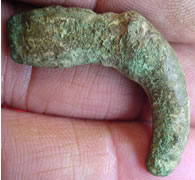  |
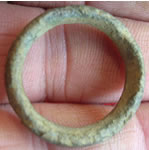 |
||
|
2ndC Roman bronze knee
brooch |
Possible Bronze age
Terret ring |
||
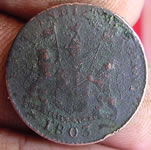 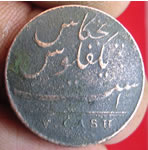 |
 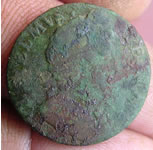 |
||
|
East India Company,
V (5) Cash from Madras, India. |
1700 William III copper
half penny in great shape
|
||
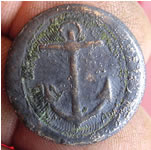 |
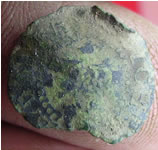 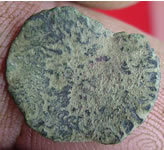 |
 |
|
|
RN Capt / Commander
- 1787 RN Lieutenant - 1787 |
1666 Thomas Peeke of
Colchester hammered copper trade farthing
|
One piece Navy button HONI SOIT QUI MAN Y PENSE PACKET Honi soit qui mal y pense (Old French: shame upon him who thinks evil of it) RN - Packet Service
c.1800-1811
|
|
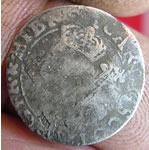 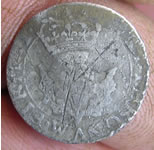 |
 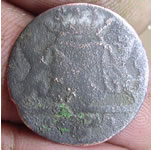 |
||
|
1625
Scottish Charles 1st hammered silver 20 pence
|
1787
Dutch duit coin
|
||
|
Roman bronze signet ring - the face is worn but appears to be T 2.43g, 21.25 mmdia |
|||
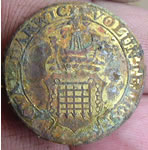 |
 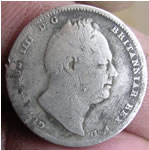 |
 |
|
|
Loyal Harwich volunteers Maker Treble gilt |
1834
William IIII milled silver 6 pence |
17thC hand decorated button | |
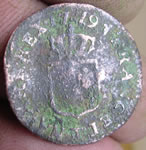  |
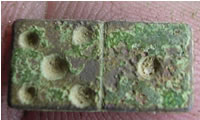 |
||
|
1719
French copper coin - Louis XVI |
Tiny
copper alloy domino - Georgian 13.18mm Long |
||
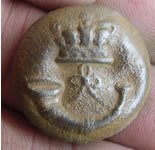 |
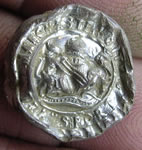 |
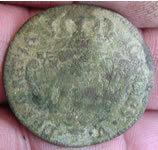 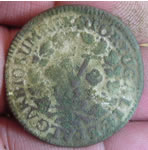 |
|
|
Possible
Rifle Regiment - not checked the books yet |
Manchester transport button |
1741
Portuguese 5 Reis copper coin |
|
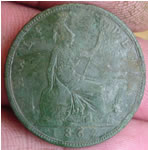 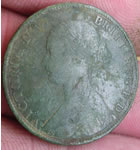 |
  |
||
|
Real
nice 1862 Victoria copper half penny |
Stunning condition Irish 1760 George III 'Voce Populi' issue copper halfpenny obv VOCE POPULI REV HIBERNIA |
||
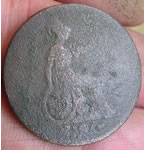  |
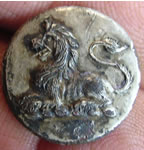 |
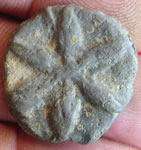 |
|
|
1821-
6 George IV copper half penny - never seen one of these |
19thC
livery button |
15thC
lead token |
|
|
|
|||
|
1stC Roman 17.27g, 28.42mm dia, 4.51mm thick sent off for ID The "guy riding
the lion" is actually the Eastern goddess Cybele, whose cult
was popular in Rome in the later 2nd century. Her "consort"
(weird thing to call him under the circumstances) Attis, as the mythos
goes, castrated himself and well as performing a related - ahem -
amputation in order that he not be distracted in any way in the purity
of his devotion to Cybele - so it was a cult with eunuch priests -
whether, if the criticisms of the era are accurate and these ad-hoc
operations were actually carried out on the spur of the moment by
devotees in transports of holy ecstasy joining in the course of the
parades and processions this sect was fond of holding, is something
I tend to doubt - but the histories are, after all, written by the
victors and they got to say pretty much whatever they wanted to, eventually.
Now, we come to the issues this coin presents - it seems, from the size, as though it should be an As - but this type isn't listed for anything in AE except Sestertii in any of my references - and actually, at 28+mm & 17.27gm, it's really too large and heavy to be an As of the era, so it pretty much has to be a Sestertius. I have several sestertii of Commodus very close to this in weight - less than 20gm - in my collection. RIC III, Rome, # 599
AE Sestertius - 191 A.D. It's pretty scarce,
too, rating an "R2" in RIC and carrying a retail estimate
in David Sear's RC&TV of 2-3 times as much as the more common
sestertii for this reign. Dating to 191, it's from the next-to-last
year of his reign - by this time he seems to have lost touch with
reality and was performing in the gladitorial arena on a regular basis
(mostly killing |
|||
|
|
|||
|
1stC Roman 12.49g,26.6mm dia, 3.97mm thick The other, less-well
preserved coin appears to be an As of Trajan (98-117 See: http://www.stoa.org/gallery/album91/ML11_Trajan_Trophy_dup for a specimen from my own collection, similar to what I think this one is - Mark |
|||
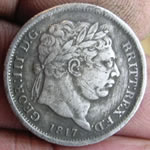  |
 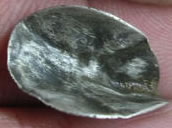 |
||
|
1817
George III milled silver shilling |
1625
Charles 1st hammered silver half groat |
||
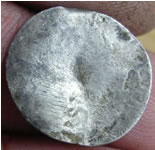 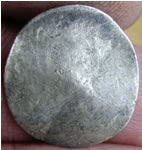 |
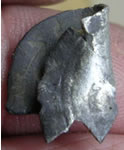 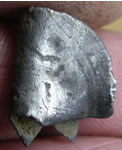 |
||
|
1704
Queen Anne milled silver sixpence |
Medieval
long cross hammered silver penny fragment
|
||
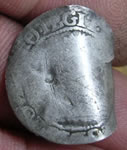 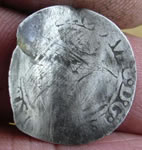 |
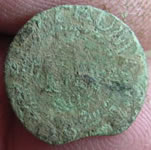 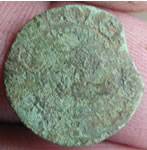 |
||
|
1603
James 1st hammered silver sixpence |
17thC
Thomas Reynolds bay maker of Colchester hammered copper trade farthing
|
||
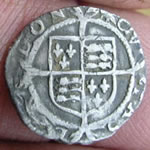 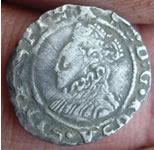 |
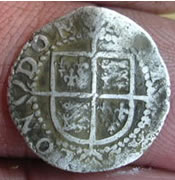 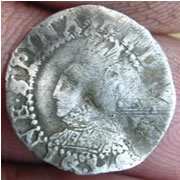 |
||
|
1560-1
Elizabeth 1st hammered silver penny - Martlet mintmark 2nd issue |
1582 - 4 Elizabeth 1st hammered silver half groat (2 pence) Fifth issue A mintmark |
||
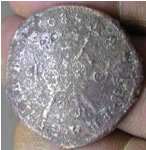 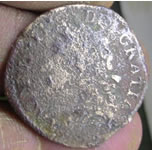 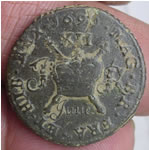 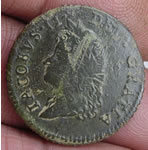 |
|||
|
Great
find - copper shilling - Aug 1689 James II Irish 'gun metal' emergency
coinage
Obv 1 - JACOBVS II DEI GRATIA - Rev 1 |
|||
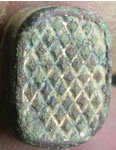 |
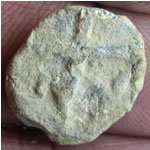 |
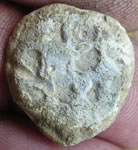 |
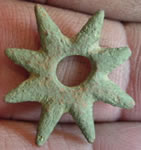 |
|
Georgian
swivel fob seal |
15thC
lead token |
15thC
lead token |
Medieval
spur rowell |
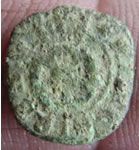 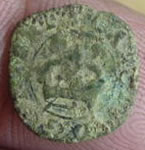 |
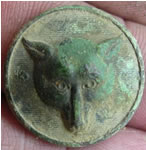 |
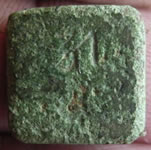 |
|
|
1634
Charles 1st Rose hammered copper farthing |
19thC
hunting button |
18th/19thC
apothecary weight |
|
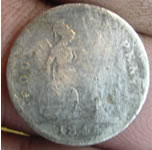  |
 |
 |
|
|
1844
Victorian milled silver four pence |
PROBABLY
? Germany / Prussia Army WWI & Prior Maker - Unknow |
Very
unusual Georgian watch winder |
|
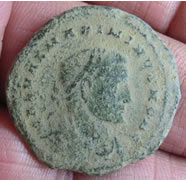 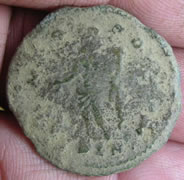 |
|||
|
Great condition Roman bronze 307AD 6.45g, 27.98mm
RIC vol VI, London, # 89a, Summer,
307 A.D. Mark
|
|||
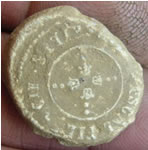  |
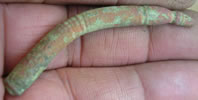 |
||
|
Post
medieval lead bale seal |
Interesting
do dad |
||
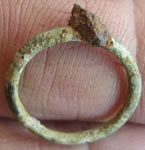 |
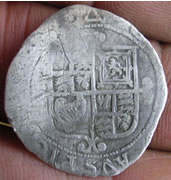 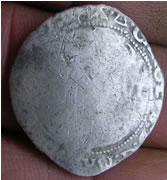 |
||
|
17thC
Small bronze ring |
1639-4
Charles 1st hammered silver sixpence - Tower mint under Charles 1st
Triangle mintmark
|
||
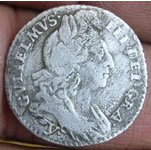 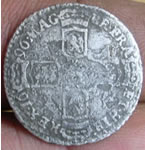 |
  |
||
|
1696
William III milled silver sixpence - Early harp large crown York mint
|
1697
William III milled silver shilling (12 pence)- Later harp small crown
3rd bust type
|
||
 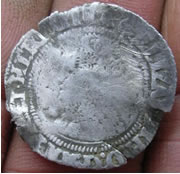 |
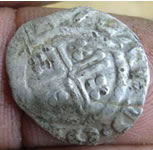 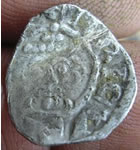 |
||
|
1560-1 Elizabeth 1st hammered silver groat (4 pence) 1st Issue Martlet mintmark |
1199AD
King John hammered silver penny 1.00g, 16.54mm
|
||
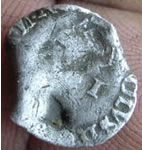 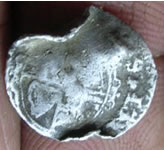 |
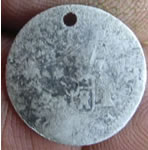  |
||
|
1645
Charles 1st hammered silver penny - Ashby mint |
18thC
Spanish milled silver pillar real |
||
 |
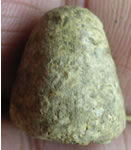 |
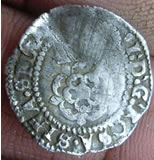  |
|
|
Neat Dutch railway button NEDERLAND SCHE SPOORWEGEN |
Lead
gaming piece |
1603
James 1st hammered silver half groat (2 pence) |
|
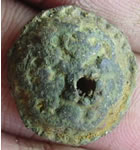 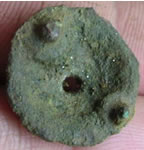 |
 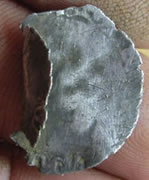 |
||
|
17thC
decorated mount with two integral lugs |
1553
Mary hammered silver groat ( 4 pence) |
||
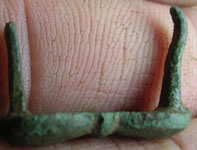  |
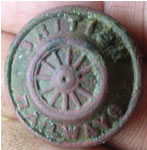 |
||
|
16thC
decorative mount with two integral lugs |
British
railways button |
||
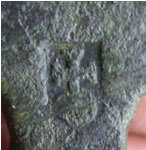  |
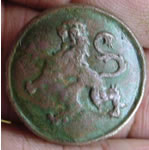 |
 |
|
|
15thC
Cockerel barrel tap key - makers mark cross |
19thC
Lion livery button |
British
railways button |
|
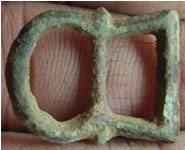 |
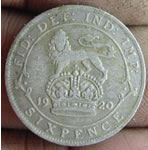 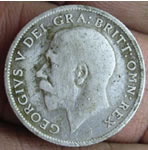 |
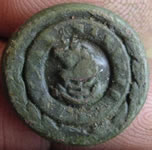 |
|
|
AD
1500-1650 buckle |
1920
George V milled silver sixpence
|
WWII
Royal Marines |
|
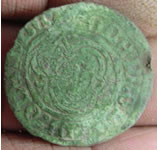 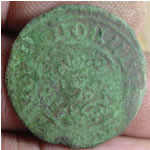 |
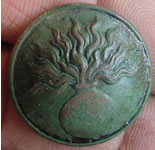 |
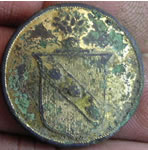 |
|
|
1586
Hans Krauwincel II Rose orb Jeton
HANNS KRAVWINCKEL IN NVRENB |
French
Infanterie de ligne (1871-1916) |
Unknown
button |
|
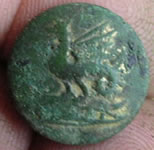 |
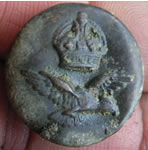 |
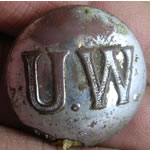 |
 |
|
19thC
livery button |
WWII
Royal air force |
?? |
1793
Suffolk Sudbury Halfpenny Conder
OBVERSE: Shield of Arms of Sudbury; dog, lion. MAY THE TRADE OF SUDBURY FLOURISH. REVERSE: PRO BONO PUBLICO 1793. EDGE: PAYABLE AT GOLDSMITH & SONS SUDBURY .XXX. |
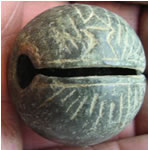 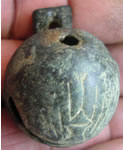 |
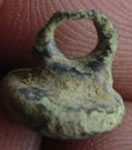 |
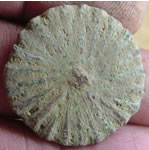 |
|
|
Stunning
decorated 16thC crotal bell with makers mark I |
16thC
Tudor button |
18thC
pastry jigger wheel |
|
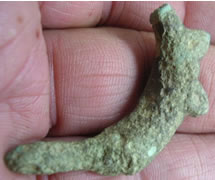 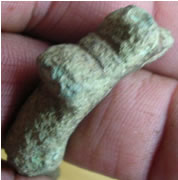 |
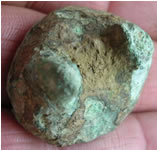 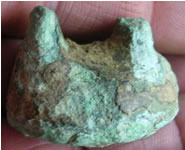
|
||
|
Bronze age /Romano British bronze piece - possible lynch pin or terret, sent to museum for ID 18.42g, 45.34mm L x9.17mm Thickest , tapering to 5.79mm dia |
Bronze
age casting plug 54.75g, 31.09L x 27.77mm Wx 22.00mm H |
||
 |
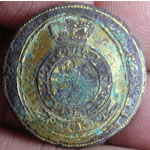 |
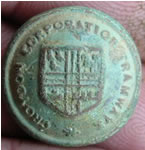 |
|
|
Great
find - 1640 English civil war cannon ball 1.8inch, 45.25mm dia, 11.2
oz - next to Victorian sixpence for size |
One piece Navy button HONI SOIT QUI MAN Y PENSE PACKET Honi soit qui mal y pense (Old French: shame upon him who thinks evil of it) RN - Packet Service
|
Croydon
Corporation transport button |
|
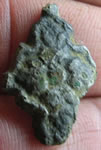 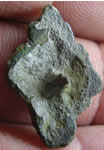 |
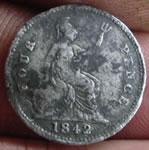 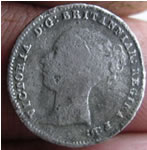 |
||
|
16thC
decorated mount - silgle integral lug |
1842
Victorian milled silver four pence |
||
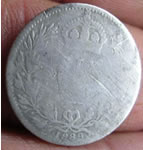  |
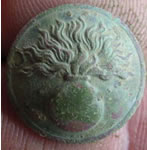 |
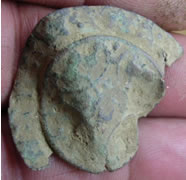 |
|
|
1889
Victorian milled silver sixpence |
French
Infanterie de ligne (1871-1916) |
Huge
Jetton like coin - no researched it yet |
|
 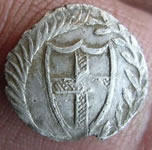 |
 |
 |
|
|
Stunning
condition 1649 Commonwealth hammered silver one pence (period without
a king)
|
17thC
copper alloy oval mount with single integral lug |
18thC
cup type bullion weight |
|
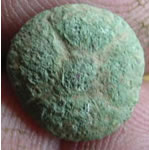 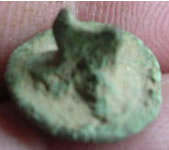 |
|
||
|
Very
unusual decorated 16thC Tudor button |
Medieval
gilded mount - two rivet fixing |
||
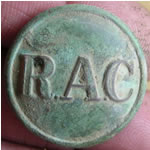 |
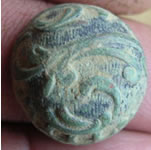 |
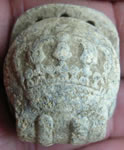 |
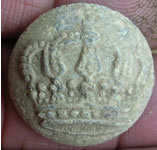 |
|
Royal
Automobile Club button |
Georgian
dress button |
Prussian
1870-1914 belt fitting |
Prussian
1870-1914 button |
|
Click here for more finds on page 2 23 hammered |
|||
 |
|||


